NIST’s NeXT Trick Will Fill Your Eyes With That Double Vision
New scanning approach combines two techniques to see more deeply into objects’ interiors.
Superman’s X-ray vision has nothing on Jake LaManna’s.
For the past couple of years, LaManna, an engineer at the National Institute of Standards and Technology (NIST), has been combining two methods of peering into the interiors of solid objects and collecting images that show how well the methods complement one another. The results, which have revealed the innards of objects ranging from ancient rock to cutting-edge batteries, suggest the Man of Steel’s X-ray perceptions would be vastly improved if he could use neutrons as well.
At the NIST Center for Neutron Research (NCNR), LaManna has built a device that can do these things. It sees with X-ray radiation and beams of slow-moving neutrons at the same time.
The two methods pair well because each can often reveal what the other cannot. Energetic X-rays—a form of electromagnetic radiation, like light—halt when they strike relatively dense materials such as stone or metal. On the other hand, chargeless neutrons penetrate these heavy substances but bounce off lighter elements like hydrogen. LaManna finds it easiest to illustrate the difference with the scan of a toy familiar to many from childhood: a Hot Wheels car, which has a metal exterior atop an undercarriage of plastic.
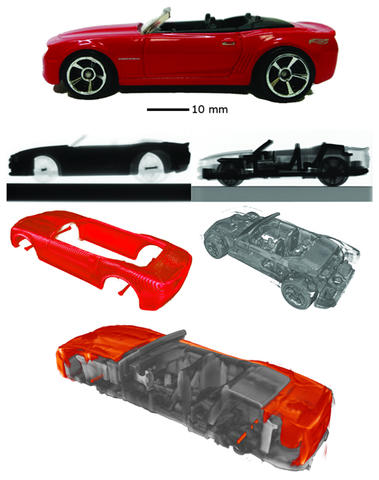
Toy cars are one thing, but LaManna got the idea in graduate school, where he was interested in developing hydrogen-based propulsion systems for real-world vehicles.
Having studied mechanical engineering in college, he knew that for hydrogen-powered cars to become practical, they would need better fuel cells to convert hydrogen into energy. But perceiving the interior workings of a fuel cell is tricky. Not only are the cells constructed out of numerous materials that as a group do not reveal their secrets through any single method, but they are also dynamic systems, with fluids flowing through and interacting within them. Seeing everything at once is important with them.
“I came across the idea for using X-rays and neutrons together from some proof-of-concept research done in 2008,” said LaManna, a staff member at NIST’s Physical Measurement Laboratory. “You need a high-intensity source to generate neutrons, such as a reactor, so you can’t do it just anywhere. A few facilities had messed around with the idea, but no one had built a detection system that worked.”
The difficulty arises from the fact that neutrons cause materials to become radioactive when they interact, and some of these radioactive materials give off gamma radiation, which can completely swamp out the X-ray signal on certain types of X-ray detectors. Additionally, the type of detector scientists frequently use is sensitive to both neutrons and X-rays, meaning they have to shield each detector from the opposite beam to minimize any cross-contamination.
LaManna’s solution was to set up a scanner that sends the two beams through an object at right angles, striking two different detectors. The neutrons flow from the NCNR’s reactor, while the X-rays shine from a compact source similar to one found in a doctor’s office. The two beams cross but do not interfere with one another, enabling them to work simultaneously. His paper describing the design of his Neutron X-Ray Tomography (NeXT) device appears in the latest issue of the Review of Scientific Instruments (RSI).
NeXT has already enabled LaManna and his collaborators to explore far more than just toy cars. It has, for example, created the first simultaneously captured composite image ever produced for the fuel cell community, showing both the cell’s channels and water flowing through the porous components—work LaManna presented at the fall 2017 meeting of the Electrochemical Society.
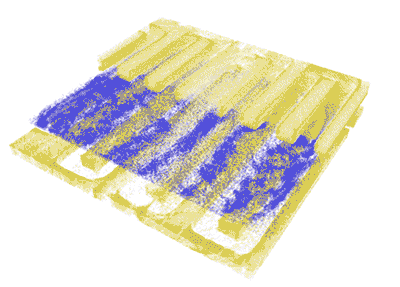
“The interfaces—where the action happens—are what you can miss here,” he said. “We can see these better. You can miss information if you use just one technique instead of both.”
This is also true for information about concrete, which in its modern form often contains aggregated materials—from sand to plastics to metal—to alter their properties. Concrete suffers degradation and damage over time, a complex process that engineers want to understand better. But with so many ingredients in the recipe, it’s important to know just what you’re looking at—something LaManna explores in the RSI paper.
“X-rays can show you bubbles in concrete that neutrons might make you think are just aggregate,” he said. “But with neutrons, you can even tell what’s in the bubbles—whether it’s air or liquid.”
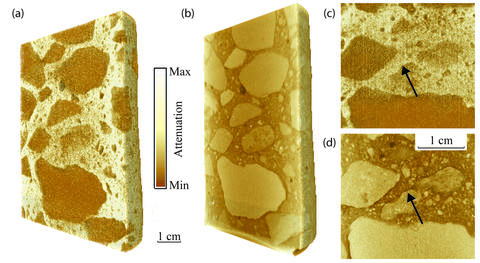
Generating a complete 3-D image can feel as slow as watching concrete harden. Each sample needs to be scanned for 10 to 30 seconds, then rotated a fraction of a degree before being scanned again. After a thousand repetitions, or about 18 hours, the sample has swung the required full circle, and then the raw data needs an afternoon’s worth of processing on a desktop computer.
“If you were to consider the neutrons going from the reactor to the detector as visible light, it would be the amount of light you’d see on a cloudy, moonless night up in the mountains: not much,” LaManna said.
But even that precious bit of light can shine in the darkest depths of the earth. Extracting natural gas from shale deposits is accomplished using a technique called hydraulic fracturing, or “fracking,” which bursts innumerable tiny pores where the gas waits. Efficient extraction requires some knowledge of how the shale is oriented. Similar to grain in wood, a shale deposit has layers that make it easier to crack in one direction than another—meaning NeXT could study shale samples brought to the lab and reveal the preferred pathway for gas transport to plan improved fracture operations.
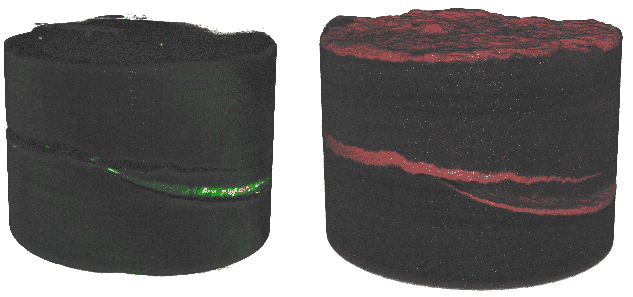
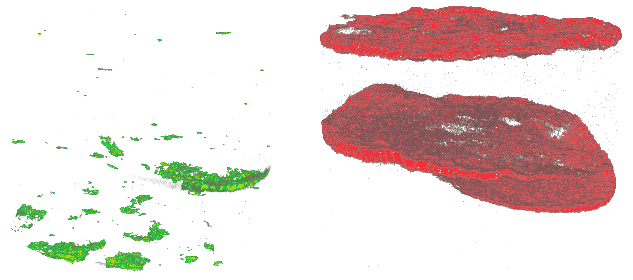
And between the layers, additional fossil energy may be hiding, said the University of Delaware’s Wei-Shan Chiang, who has collaborated with LaManna to analyze shale samples obtained by the Aramco Research Center in Houston, Texas.
“Typical techniques analyze shale at the pore scale,” Chiang said, “but NeXT provides details at the core scale. We can see layers we haven’t seen before that are rich in organic material, and these are likely where the hydrocarbons accumulate.”
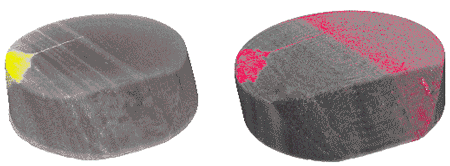

The NeXT pressure cell is a cylinder 38 millimeters (mm) wide and 150 mm long, about the size of a grilled bratwurst sausage. It can accommodate pressures up to about 11,000 kilopascals (kPa), or 1,600 pounds per square inch. LaManna says if he can get it up to about 27,500 kPa (4,000 psi), it will be useful for core samples brought up from far deeper underground.
Another underground application involves not removing carbon, but getting it back underground—a concept called carbon sequestration. In order to store carbon successfully for millennia in salt domes and old, exhausted oil reservoirs, it will be crucial to ensure these natural storehouses don’t leak.
Often sitting atop these structures is a layer of limestone that must not develop any holes. Unfortunately, that’s what limestone frequently does. Many of the world’s caves are in limestone, once solid but hollowed out by water made slightly acidic by dissolved carbon dioxide.
“We don’t want the carbon to eat its way back to the surface,” LaManna said. By examining limestone samples, “NeXT is helping us understand how this process happens. We can even create animations of how it flows and changes.”
|
|
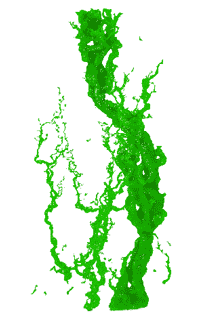
Credit:
LaManna/Hanacek, NIST
|
NeXT is currently the only system of its kind in the world, and will likely remain so for the foreseeable future, at least in the Western Hemisphere. X-rays are relatively easy to come by, but neutrons are a rare commodity. While the NeXT system is working quite well, LaManna sees many opportunities to improve the versatility and robustness of the system. He plans to spend the next few years developing the scanning technique, improving the X-ray source and designing novel sample environments.
Paper: J. LaManna, D. Hussey, E. Baltic and D. Jacobson. Neutron and X-ray Tomography (NeXT) system for simultaneous, dual modality tomography. Review of Scientific Instruments. Published November 2017. DOI: 10.1063/1.4989642.

